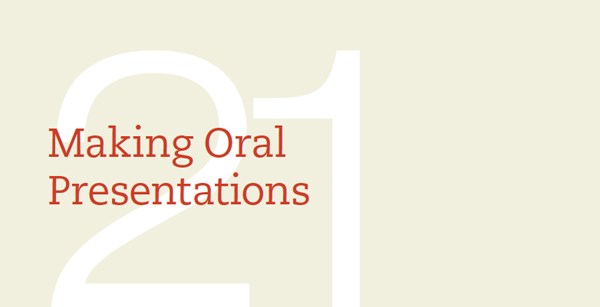21 Making Oral Presentations
Printed Page 576-577

Understanding the Role of Oral Presentations
Understanding the Process of Preparing and Delivering an Oral Presentation
Preparing the Presentation
ANALYZING THE SPEAKING SITUATION
ORGANIZING AND DEVELOPING THE PRESENTATION
• GUIDELINES: Introducing the Presentation
• GUIDELINES: Concluding the Presentation
PREPARING PRESENTATION GRAPHICS
TUTORIAL: Creating Presentations with PowerPoint and Prezi 
TUTORIAL: Audio Recording and Editing with Audacity 
• TECH TIP: How To Create a Master Page Design in PowerPoint
• TECH TIP: How To Set List Items To Appear and Dim During a Presentation
CHOOSING EFFECTIVE LANGUAGE
• DOCUMENT ANALYSIS ACTIVITY: Integrating Graphics and Text on a Presentation Slide
• GUIDELINES: Using Memorable Language in Oral Presentations
REHEARSING THE PRESENTATION
Delivering the Presentation
CALMING YOUR NERVES
• GUIDELINES: Releasing Nervous Energy
USING YOUR VOICE EFFECTIVELY
USING YOUR BODY EFFECTIVELY
• GUIDELINES: Facing an Audience
Answering Questions After a Presentation
• ETHICS NOTE: Answering Questions Honestly
Sample Evaluation Form
DOWNLOADABLE FORM: Oral Presentation Evaluation Form 
SPEAKER’S CHECKLIST
EXERCISES
CASE 21: Understanding the Claim-and-Support Structure for Presentation Graphics and 
A recent search for “death by PowerPoint” on Google returned some 1,410,000 hits. Apparently, a lot of people have been on the receiving end of boring presentations built around bullet slides. But an oral presentation—with or without slides—doesn’t have to be deadly dull.
And the process of creating and delivering a presentation doesn’t have to be frightening. You might not have had much experience in public speaking, and perhaps your few attempts have been difficult. However, if you approach it logically, an oral presentation is simply another application you need to master in your role as a technical professional or technical communicator. Once you learn that the people in the room are there to hear what you have to say—not to stare at you or evaluate your clothing or catch you making a grammar mistake—you can calm down and deliver your information effectively while projecting your professionalism.
There are four basic types of presentations:
- Impromptu presentations. You deliver the presentation without advance notice. For instance, at a meeting, your supervisor calls on you to speak for a few minutes about a project you are working on.
- Extemporaneous presentations. You plan and rehearse the presentation, and you might refer to notes or an outline, but you create the sentences as you speak. At its best, an extemporaneous presentation is clear and sounds spontaneous.
- Scripted presentations. You read a text that was written out completely in advance (by you or someone else). You sacrifice naturalness for increased clarity and precision.
- Memorized presentations. You speak without notes or a script. Memorized presentations are not appropriate for most technical subjects because most people cannot memorize presentations longer than a few minutes.
This chapter discusses extemporaneous and scripted presentations.